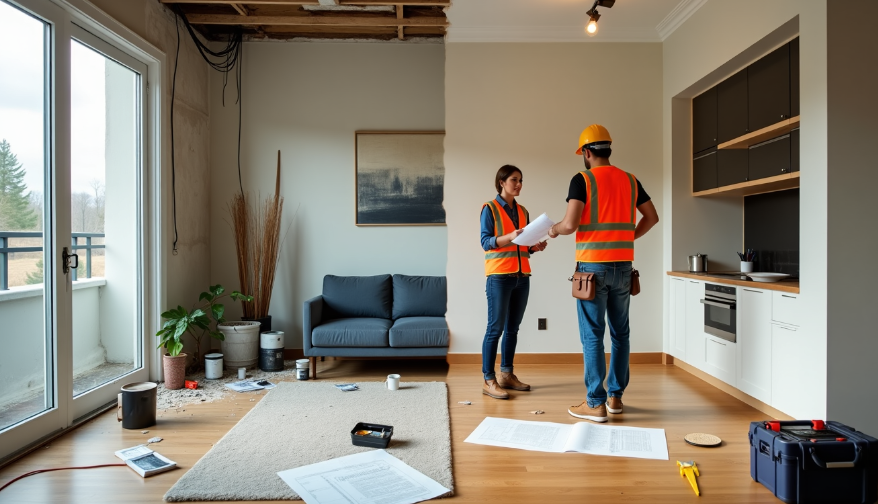Hidden renovation mistakes that cost homeowners thousands

Every homeowner dreams of a space that reflects their taste, comfort, and lifestyle. Renovation is often the path to achieving that dream—but beneath the surface of tile samples and paint swatches lurk problems that can turn that dream into a budgetary nightmare. From misjudged layouts to overlooked plumbing, some of the most expensive renovation mistakes aren’t obvious until it’s far too late.
Whether you're planning a bathroom renovation, kitchen upgrade, or finishing your basement, hidden errors during the process can cost thousands. The worst part? Most of them are entirely avoidable with proper foresight, reliable professionals, and attention to detail.
Underestimating what's behind the walls
One of the most costly renovation mistakes is assuming what you don’t see isn’t a problem. Old wiring, rusted pipes, or poorly insulated walls may not be visible at first glance—but they can derail your timeline and budget in an instant.
In bathrooms, outdated or corroded plumbing is a particularly expensive oversight. Homeowners often replace fixtures and tiles without inspecting the underlying water supply or drainage lines. A fresh new space won’t mean much if water starts leaking behind the walls a few months later.
What to do instead:
Before starting your bathroom renovation, have a licensed plumber and electrician inspect the area. If your home is older than 30 years, it's even more critical. Investing in pre-renovation inspections is cheaper than mid-renovation repairs.
Ignoring waterproofing requirements
Bathrooms are high-moisture environments. Waterproofing isn’t optional—it’s a critical component of the renovation. Unfortunately, many homeowners and even some contractors cut corners here, especially when budgets get tight.Improperly sealed showers, poorly installed membranes, or skipped waterproof coatings behind tiles can lead to mold growth, water damage, and structural rot. These problems don’t just ruin finishes; they compromise the integrity of your home.
What to do instead:
Use certified waterproofing products and follow building codes. Hire contractors with experience specifically in wet-area construction. Request proof of waterproofing steps before tiles are installed.
Misjudging ventilation needs
A stylish bathroom filled with steam and humidity is a recipe for mold, mildew, and early material deterioration. Ventilation is often underestimated or left as an afterthought—especially in small bathrooms or those without windows.
Excess moisture can damage drywall, warp cabinetry, and deteriorate grout and caulking, costing homeowners thousands in rework.
What to do instead:
Install a properly sized exhaust fan and ensure it vents to the outside, not into the attic. Look for fans with humidity sensors or timers. Good airflow extends the life of your renovation and prevents hidden damage.
Skipping permits and inspections
Skipping permits may seem like a way to save time and money. But if something goes wrong or you plan to sell your home, unpermitted work can come back to haunt you. Insurance companies may deny claims for damages related to unapproved renovations, and home buyers are often turned off by missing documentation.
Bathroom renovations often involve electrical, plumbing, and structural changes—any of which may legally require a permit, depending on your local codes.
What to do instead:
Call your local building department or work with a contractor who manages permitting. The cost of permits is minimal compared to legal or resale complications later.
Choosing beauty over functionality
It’s easy to get caught up in visual design and forget about practical use. Beautiful, minimal vanities might not provide enough storage. Stylish wall-mounted faucets can be hard to repair. Giant freestanding tubs may look amazing—until you realize they’re rarely used and dominate the space.In many failed home renovation projects, the issue isn’t poor craftsmanship—it’s poor planning.What to do instead:
Think about how the space will be used daily. Prioritize comfort, storage, and durability over trends. Consult professionals for layout guidance to avoid design regrets after installation.
Hiring the wrong contractor
Low bids may look appealing, but they often come with hidden costs. Incomplete work, substandard materials, or costly fixes can follow. In some cases, homeowners are left with half-finished projects and no legal recourse.
A good contractor brings more than labor—they bring insight, coordination, and quality control. Choosing the wrong one can undo all your planning and stretch your budget well beyond your expectations.What to do instead:
Research thoroughly. Ask for references, check licenses and insurance, and review past work. Sign a detailed contract that outlines scope, timeline, materials, and payment schedule.
Not budgeting for surprises
Even with the best planning, renovations often uncover something unexpected. A floor that isn’t level. Pipes in the wrong place. Structural framing that needs reinforcement. These aren’t rare—they’re typical.
Failing to include contingency funds in your budget can leave you stressed and scrambling.
What to do instead:
Set aside at least 15–20% of your total renovation budget for contingencies. This gives you room to make necessary fixes without derailing the entire project.Renovation mistakes rarely happen because people don’t care—they happen because people don’t know what to expect. When armed with the right knowledge, homeowners can protect their investment and enjoy their renovated spaces without the burden of costly surprises.Paying attention to what’s beneath the surface, asking the right questions, and bringing the right experts on board can make all the difference between a renovation that pays off—and one that drains your savings.